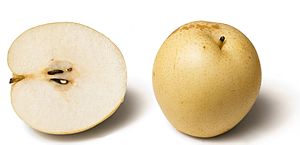Cookbook:Asian Pear
| Asian Pear | |
|---|---|
 | |
| Category | Fruits |
Cookbook | Recipes | Ingredients | Equipment | Techniques | Cookbook Disambiguation Pages | Ingredients | Fruit
Asian pears are a class of pears that typically have a rounded shape, similar to an apple. They may also be called Chinese pears, Japanese pears, Korean pears, sand pears, nashi pears, or apple pears.[1]
Characteristics
editAsian pears are usually round, firm to touch when ripe, and ready to eat after harvest. They have golden, slightly rough skin and white flesh.[2] Unlike Western pears, which are soft in texture, Asian pears are crisp, juicy, and slightly sweet with some tartness, especially near the core.[1]
Varieties
editThere are several Asian pear varieties available. Japanese pears are more round in shape, while Chinese pears are more oval or pyriform.
In the United States, the Japanese type of Asian pear called 20th Century or Nijisseki is the most popular. It is easily identified by its round shape and smooth yellow skin. Other common varieties include the Japanese bronze-toned Hosui pear and the pear-shaped Ya Li, a pale-green Chinese variety.
Seasonality
edit| Seasonality tables | Autumn | Winter | Spring | Summer | All year | ||||||||||||
|---|---|---|---|---|---|---|---|---|---|---|---|---|
| Asian Pears | Jan | Feb | Mar | Apr | May | Jun | Jul | Aug | Sep | Oct | Nov | Dec |
| Northern hemisphere | ||||||||||||
| Southern hemisphere | ||||||||||||
The harvest season in the northern hemisphere usually begins in mid July and lasts until fall and winter.[2]
Selection and storage
editAsian pears reach prime quality when they ripen on the tree, like apples and peaches do.[1][2] Select the most fragrant and unbruised fruit with few to no brown spots. Ripe Asian pears are hard and do not soften. They are ready to eat when purchased.[1]
These fruits are known for keeping well. Store pears for up to a week at room temperature or up to three months in the refrigerator.[1] If planning to use them in cooking, they can be cut up and frozen.[2]
Use
editAsian pears have many raw applications. With their crisp sweetness, they are excellent when eaten straight, as they are often in Korean homes.[1][2] They can also be incorporated into salads in the same way as apples, and they are used in marinades to flavor meats.[1][2] While these pears can be cooked into sauces and baked goods, note that their high water content will require longer cooking to concentrate their flavor and texture.[2]